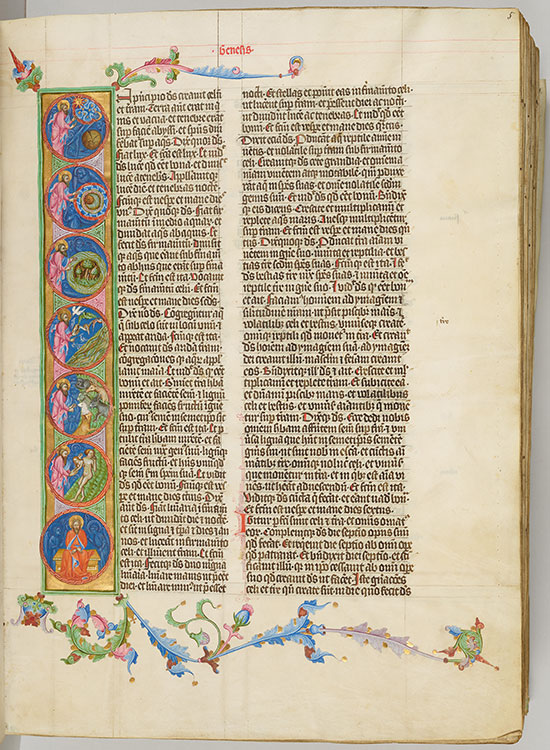
PRAGUE: A NEW CAPITAL
Named after its scribe, Andreas, this Bible was illuminated by four artists, a complex collaboration typical of court production in Prague during the reign of Emperor Wenceslas IV (r. 1376–1400). Its intended recipient was likely the scribe’s benefactor, William of Hasenburg (d. 1393), who had close ties to court and to the August-inian monastery at Roudnice nad Laben, the country seat of Prague’s archbishops. Marking the beginning of Genesis, the large initial I comprises seven medallions depicting Creation. The uppermost conflates the first and fourth days: the separation of light and dark and the creation of the sun, moon, and stars. The second roundel shows Earth, at center, surrounded by bands representing water and air. Together, the two medallions refer in schematic fashion to the cosmological system devised by Ptolemy (ca. 100–170), whose works were familiar at the court of Wenceslas due to the monarch’s obsessive interest in astrology.
"Bible of Andreas of Austria," in Latin
Written by Andreas of Austria for William of Hasenburg (d. 1393)
Czech Republic (Bohemia), Prague or Roudnice nad Laben, 1391
The Morgan Library & Museum, MS M.833, fols. 4v–5r
Purchased on the Belle da Costa Greene Fund, 1950
Jeffrey Hamburger, Kuno Francke Professor of German Art & Literature, Harvard University
The flourishing court culture at Prague attracted scholars and craftsmen from all corners of the Empire. One such scribe, Andreas of Austria, names himself in the colophon he added to this giant bible, dated 1391.
Although Andreas did not write the entire bible himself, his having taken credit for the whole suggests that the volume was his gift to a patron. That patron may well have been William of Hasenburg, father of a future archbishop of Prague, who may have had ties to the nearby Augustinian monastery at Roudnice nad Labem, a country seat for the archbishops where the bible may have been made.
The large initial I for Genesis belongs to a type coined in the late eleventh century. Occupying six vertically disposed medallions (one for each day of Creation),the Hexameron towers above the figure of Christ-Logos enthroned among angels, resting on the seventh day. Such scenes of Creation usually run from bottom to top, like a stained-glass window, with God crowning the image. Here, however, the direction has been reversed.
Such Genesis initials offered opportunities for cosmological speculation. The uppermost medallion conflates the first and fourth days: the separation of light and dark and the creation of the sun, moon, and stars. Against a celestial background filled with angels, the Christ-Logos blesses a celestial orb on whose circumference sit the sun and moon. The sphere below, split into quadrants by large cracks, represents the four elements. In the second medallion, the Earth is surrounded by offset circles of water and air. Together, the two medallions refer in schematic fashion to the system devised by Ptolemy, whose works were familiar at the court of Emperor Wenceslas on account of his obsessive interest in astrology.
